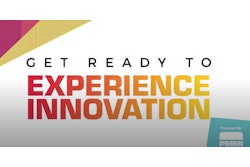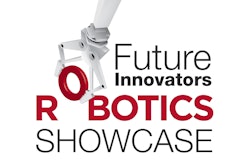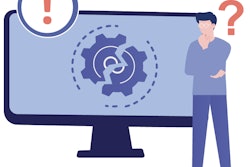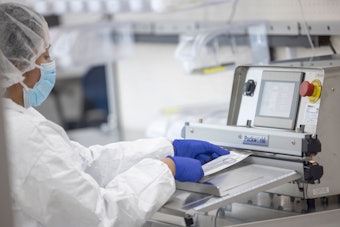Joining this episode of unPACKed with Packaging World is Packaging and Processing Hall of Fame member and Editor Emeritus of Packaging World, Pat Reynolds. Reynolds discusses the emergence of paper bottles and some pretty big names, including Nestle, Unilever and L’Oreal, who have started incorporating these groundbreaking bottles essentially made out of recycled paperboard and old newspapers.
To subscribe, rate, review and find more unPACKED podcast episodes, visit pmmi.org/podcast or find us on Apple podcasts, Spotify or iHeart Radio.
 | Read the full transcript below. |
Sean Riley:
Pat Reynolds, welcome back to the podcast.
Pat Reynolds:
Well thanks, Sean. It's certainly good to be with you again.
Sean:
So, you've been following the development of paper bottles for quite some time now. I feel like you covered it during PACK EXPO Connects, think I've seen you do some video on it as well. And it sounds like there's been a pretty big introduction in this space by pretty big Nestle brand, Vittel. I guess, could you tell us more about that?
Pat Reynolds:
Well Sean, one of the things that makes it notable is the simple fact that it comes from a high-flying brand like Nestle, and adding a little intrigue to it all is that rather than making its debut on store shelves, it was introduced in conjunction with that little old bike race called the Tour de France.
Sean:
Yeah, that's a pretty big stage to unveil something like that. How much does it hold? What's the basic composition? What's the story behind this bottle that they would unveil it at a place like that?
Pat Reynolds:
Yeah, this is a one liter bottle. And in fact, it's a paper/plastic hybrid approach. It's actually a new take on the paper bottle we've been seeing from Ecologic brands. Now that's the Manteca, California based firm that was purchased in January, and is now part of the Jabil Packaging Solutions. We'll circle back on this acquisition in a moment because it may be a pretty significant development in its own right.
Pat Reynolds:
But I asked for the bottle's composition, it consists of two thermo-formed fiber shells with interlocking tabs. Now this is familiar enough as it's the basic format used by Ecologic customers in the past. And once again, the fiber shells are made of recycled paperboard and old newspapers. But, and here's where it starts to get interesting, while recent offerings from Ecologic included an inner liner that is extrusion blown of 80% post-consumer high density polyethylene, the liner in this Vittel bottle is injection stretch blow molded of 100% recycled PET.
Pat Reynolds:
This liner is also notably svelte at just nine grams. Now, who makes the PET liner and how is it married to the fiber shells? These are questions I have not been able to get answered just yet, nor do I know what kind of label is involved or decorated for that matter. But such details are a bit hard to come by at this stage partly because the innovative bottle is really more of a trial than a launch.
Sean:
It's interesting that there's options on just what kind of liner Ecologic is capable of using. And I assume the basic idea is for the consumer to separate the liner from the fiber material, and then I guess, put them in each of their own appropriate recycle streams?
Pat Reynolds:
Yes, that's exactly right. But this is where the Vittel bottle, once again, represents a departure from Ecologic bottles we've seen in the past. Included in this bottle is a tear tab that will make it even easier for consumers to separate the fiber shells from the PET liner. Once again, I wish I could provide a few specifics on how and when, and on what kind of equipment this tear strip gets added. But, alas.
Sean:
Yeah. In my opinion, with the way consumers, especially in North America, are about recycling, and I'll use the word lazy to a degree, does the bottle have specific messaging that can guide the consumer and basically spell out exactly what they have to do to get these components into the proper recycle streams rather than just giving up and throwing it in the regular trash?
Pat Reynolds:
Yeah, that's a good point. And there are, in fact, some pretty explicit directions on the bottle, which as you point out, are probably going to be necessary.
Sean:
All right. I guess let's circle back to what you said earlier about a Jabil's acquisition of Ecologic. What's the big deal? Why do you think this could turn out to be significant in the development of the paper bottle?
Pat Reynolds:
Well, it's partly because the very idea of a paper bottle is viewed by many with a good deal of skepticism. And why the skepticism, you might ask? Well, look how long Carlsberg has been prototyping a paper bottles for beer, or ask Paboco, a consortium that includes Cole, L'Oreal, and Absolut, or ask Pulpex, another consortium, which includes Diageo and Unilever, when their paper bottle offerings will actually be commercialized.
Pat Reynolds:
Now, I should note here that Unilever and Pulpex announced on June 10 that they planned to launch a paper-based laundry detergent bottle for Unilever's Omo brand in Brazil by early 2022. The bottle is designed to be recycled in the regular paper waste stream, and making this almost bottle all the more fascinating is that rather than relying on a plastic insert, it will be sprayed inside with a proprietary coating that repels water or moisture of any kind.
Pat Reynolds:
But this bottle for Unilever's Omo is only at a prototype stage at the moment, and that's really been the fundamental problem with paper bottles for the past few years. Announcements come and go, but bottles seem stuck at prototype stage and are just not reaching consumers in any measurable numbers so far. So, the skepticism about the true viability of a paper bottle is well-founded and probably inevitable. I've been just as skeptical as the rest, as in, "Wait, you're going to put liquid in a paper bottle and expect it not to leak?"
Pat Reynolds:
Now, getting back to the Ecologic/Jabil union, it's notable because it brings Ecologic, essentially a startup, mind you, the vast engineering skills and financial resources of Jabil, a Florida based Fortune 200 juggernaut with annual sales of $27 billion. What Ecologic has hoped to do for some time now is ship nested shells to customers around the world where blow molding or injection stretch blow molding of the inner liner would also be done.
Pat Reynolds:
This would greatly optimize the sustainability of the container because then, rather than shipping empty bottles to its customer base, Ecologic would nest the fiber shells and have them efficiently assembled in locations relatively close to brand or customers, or maybe the brand owners themselves would install automated assembly equipment designed by Ecologic/Jabil.
Pat Reynolds:
So far, this model has been elusive because the highly specialized automated equipment currently used to assemble bottles only exists, at this point in time in Ecologics' Manteca, California facility. But with the resources of Jabil behind Ecologics' efforts... Now remember, Jabil has 100 sites in 26 countries and it offers design engineering expertise in life sciences, defense, automotive, computing, networking, and telecommunications. So with these resources are available to Ecologic, optimizing automated assembly equipment and getting it built and distributed globally, becomes just a tad less daunting.
Sean:
Yeah. Almost everything you're saying is exactly how I look at it, where again, you're putting the liquid into paper and just, the concept of it is hard to wrap your head around. So I guess, I've read all the stories that you've had about this and viewed some of the videos and all the content that you have based around these paper bottles. And I think from what you're saying, it sounds like there's basically two approaches when it comes to commercializing paper bottles that can indeed hold liquids, which is still hard for me to wrap my head around.
Sean:
So one involves a plastic liner, which is going to be made as light as possible, obviously. And one relies on, I guess, a coating. So in a perfect world, is there a way to eliminate the plastic entirely? Is that pretty much the way that it's shaking out?
Pat Reynolds:
Yeah, that's about right Sean. You have to root for the camp that's working on the coatings, because if they do get to where they want to be, the consumer won't have to go to the bother of separating out plastic and paper components. The whole bottle will go right into the paper recycled stream. But as much as we'd like for this to be the solution that wins out, it's important to point out that so far, the approach that has succeeded in the marketplace, on a commercial basis, has been the plastic liner approach. That's why Ecologic founder, Julie Corbett, constantly emphasizes that while there are many fascinating paper bottle technologies moving forward, and while many of them hold great promise, so far, at least, the one that has had the most success in making its way into the hands of the consumer is the paper bottle that includes a thin plastic lining.
Sean:
So, do you think that means at least for now or going forward, that Ecologic is married to the plastic liner, or are they investigating ways to incorporate coatings a little bit more?
Pat Reynolds:
Yeah, that's a great question, Sean. And last time I spoke with Corbett at Ecologic, she made it very clear that Ecologic has been looking at coatings since way back in 2010. But to this day, coatings simply have not been proven to be commercially viable. "And Ecologic," says Corbett, "is focused on delivering what consumers need today."
Sean:
I mean, I guess I can't knock that kind of consumer focused approach, can you? But this paper bottle arena, it's definitely one of these things we're keeping an eye on. But getting back to Vittel, just for a moment. At some point, I remember you telling me that there's another sustainable packaging concept they've launched and it involves a reusable outer container that holds product containing inserts?
Pat Reynolds:
Yeah, that's right. And I have to say, it's a pretty cool idea. They call it the Vittel GO system. It consists of a reusable hard protective plastic case, designed to hold 50 centiliter refills of natural mineral water. And these refills are made with 40% less plastic than a traditional 50 centiliter PET bottle.
Pat Reynolds:
Once again, I'd love to know the identity of the plastic resin used to make the case and the refills, but that information has not been made available. I'm thinking the case is injection molded polypropylene, and the refills are injection stretched blow molded PET.
Pat Reynolds:
I'm also guessing, and I'm guessing here, that the inserts are close cousins to the ultra thin inner liners we're seeing in the paper bottle. In other words, both plastic containers probably spring from the same design and development process and are probably injection stretch blow molding in similar molds, on similar machines. And I will add that, I sure wish I knew who makes the free forms for such incredibly light containers.
Sean:
Interesting. And this also piggybacks off of a podcast we did previously with Anne Marie Mohan on un-reusables, and the need to incorporate them more in the sustainable stream and get reusables out there more to eliminate waste in general. So I guess please, be sure to keep us posted should you wind up learning anything more on that and maybe we'll circle back on that. So I guess, is there anything else up your sleeve, or anything else you've heard, where fiber-based containers are concerned?
Pat Reynolds:
Yeah, actually, there's two more developments that are worth looking at. The first comes from global cosmetics and beauty aids manufactured L'Oreal, and global cosmetics packaging manufacturer, Albea. Both headquartered in France, these two firms recently announced that they have invented what they're calling the first carton-based cosmetics tube where plastic is, for the most part, replaced with what L'Oreal and Albea call a bio-based and certified paper-like material.
Pat Reynolds:
The first L'Oreal brands to appear in the new tube are La Roche-Posay and Anthelios sun care product, and there are many Garniers' bio skincare products. Once again, details on manufacturing methods and container composition are a little bit harder to come by. But it's worth noting this is far from L'Oreal's first foray into paper-based bottles. Back in 2018, it's seed phytonutrients brand launched in a paper bottle from Ecologic. And it's also worth noting that L'Oreal is an active member of the Pacobo consortium that I mentioned earlier.
Pat Reynolds:
And that brings me finally to the other development I wanted to mention, which in fact comes out of Coca-Cola and Pacobo. That would be the limited online trial of Coke's plant-based beverage, A to Z, in a paper bottle that is described as a paper shell with a recyclable plastic lining and cap. This bottle will be offered by an e-grocery retailer in Hungary, sometime the summer.
Sean:
So to wrap up what we've just covered, what I'm hearing is happening in the paper-based bottle world is, a lot of these big name companies, which is what we'd like to hear; the Nestle's, the Coca-Cola's, the L'Oreal's, are getting involved with this paper-based packaging. So while it might still be in its infancy, it's something that is clearly caught the interest of the biggest players in the markets that are going to make this less of a thing that we get surprised and have podcasts about, and more of something that we see every day.
Pat Reynolds:
I think that's exactly right, Sean, you really hit the nail on the head. You move the needle when these big brands get involved, and then they cause things to happen, I think, a little more readily than some of the smaller ones.
Sean:
Right, and if they are interested, it means that there clearly is some viability to this. It's not just a pie in the sky idea if the Cokes and the Nestles are involved. So, that's fantastic to hear, and hopefully we'll be able to circle back with you when we get some more information or any new developments on something like this. So we just want to thank you again for taking time out of your day to come on here and give us details on a topic that I'm sure most people listening don't know nearly as much as you do about.
Pat Reynolds:
Well, I'll be happy to keep you posted as developments emerge.





















